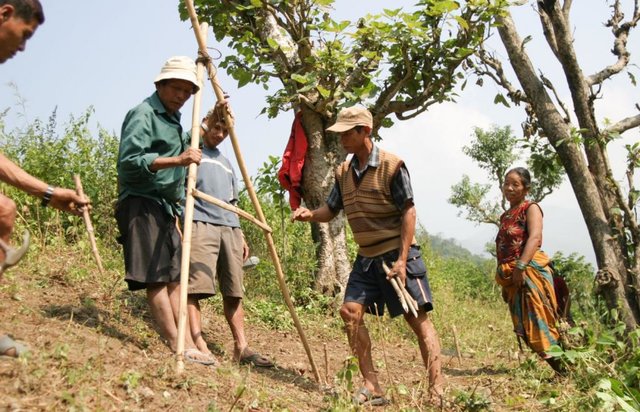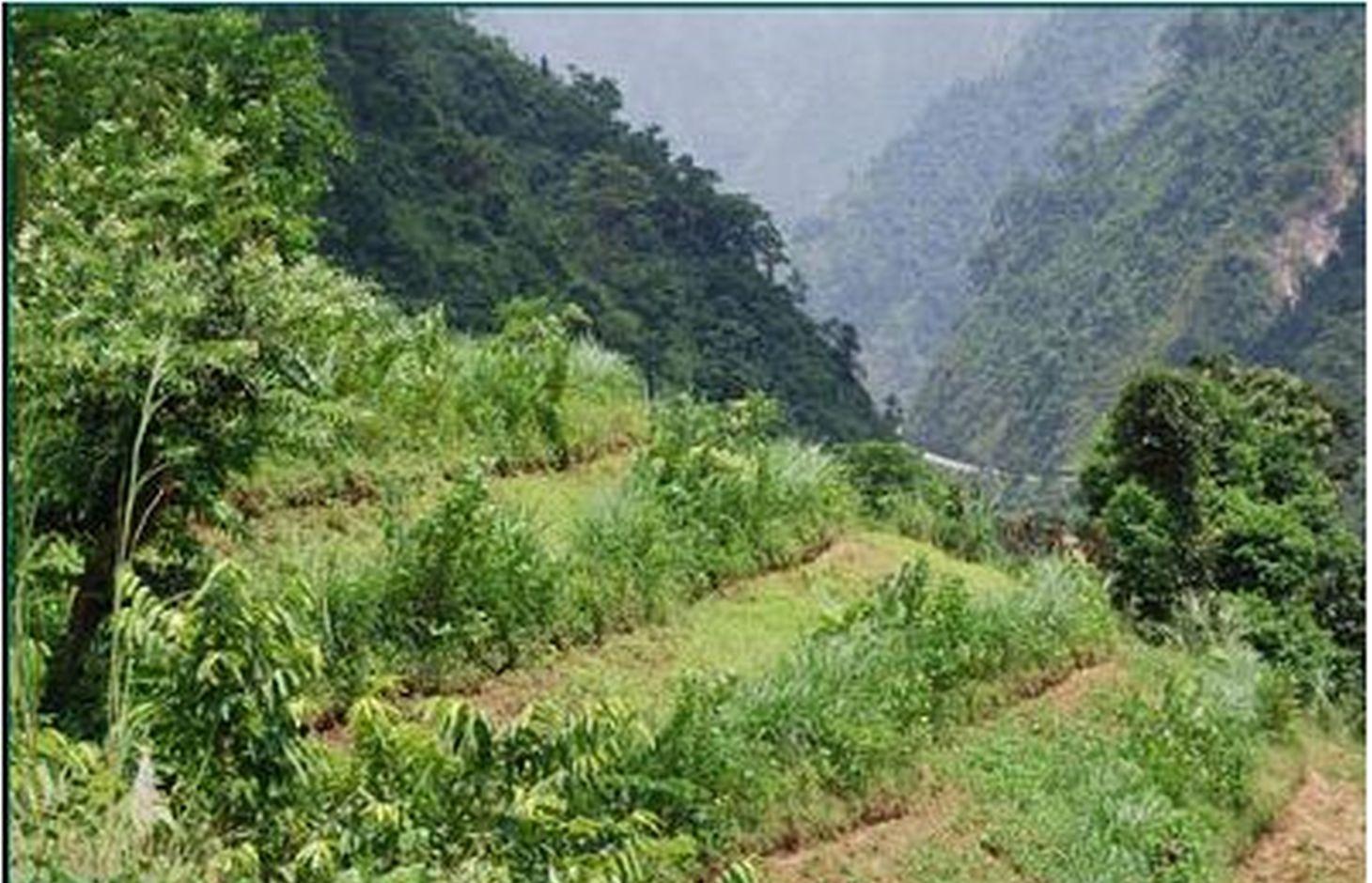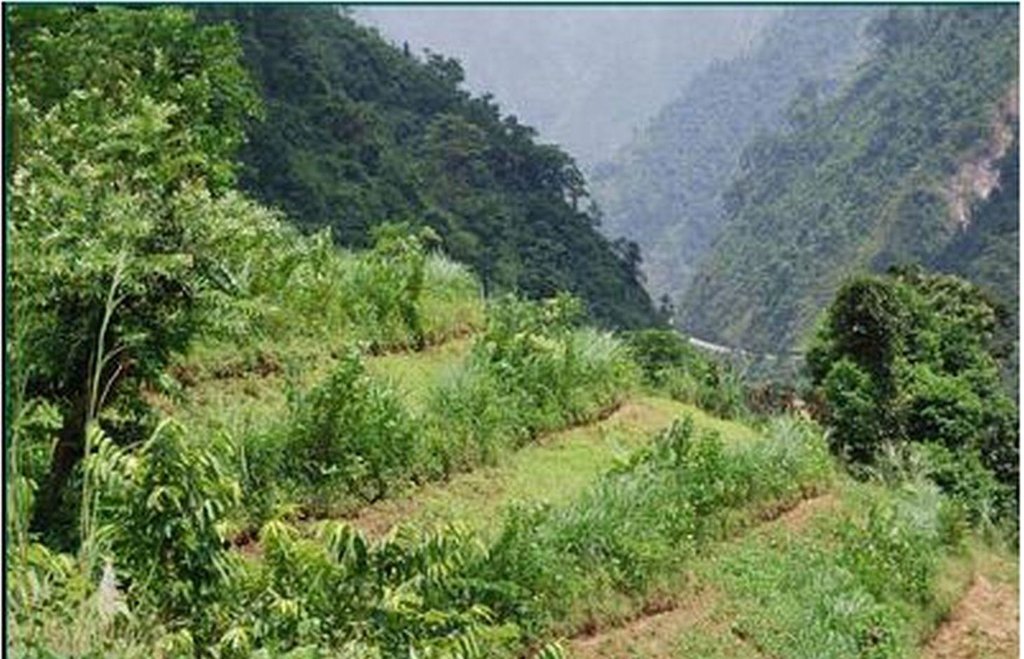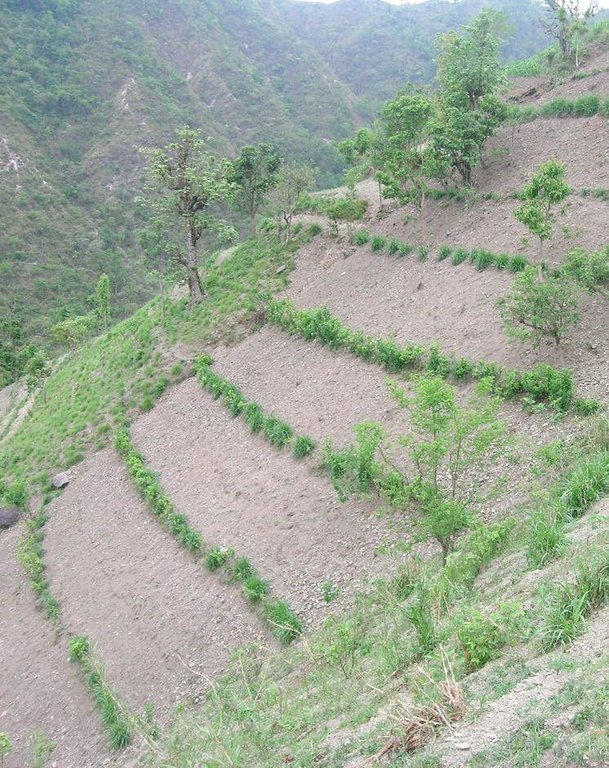Hedgerow technology [Nepal]
- Criação:
- Atualização:
- Compilador/a: Shreedip Sigdel
- Editor: –
- Revisor: David Streiff
Ghase har Prabadhi (Main Contributor: Gyanbandhu Sharma, LI-BIRD)
technologies_1685 - Nepal
Veja as seções
Expandir tudo Recolher tudo1. Informação geral
1.2 Detalhes do contato das pessoas capacitadas e instituições envolvidas na avaliação e documentação da tecnologia
Especialista em GST:
Nome da(s) instituição(ões) que facilitou(ram) a documentação/ avaliação da Tecnologia (se relevante)
Local Initiatives for Biodiversity, Research, and Development (LI-BIRD) - NepalNome da(s) instituição(ões) que facilitou(ram) a documentação/ avaliação da Tecnologia (se relevante)
ICIMOD International Centre for Integrated Mountain Development (ICIMOD) - Nepal1.3 Condições em relação ao uso da informação documentada através de WOCAT
Quando os dados foram compilados (no campo)?
01/03/2013
O/a compilador/a e a(s) pessoa(s) capacitada(s) aceitam as condições relativas ao uso de dados documentados através da WOCAT:
Sim
1.5 Referência ao(s) questionário(s) sobre as abordagens da GST

Participatory hedgerow management [Nepal]
Hedgerow technology can be introduced through the joint participation of farmers, scientists, and related stakeholders. The whole community works together at all stages, including designing, planning, implementation, monitoring and evaluation, and scaling up.
- Compilador/a: Shreedip Sigdel
2. Descrição da tecnologia de GST
2.1 Descrição curta da tecnologia
Definição da tecnologia:
A technology that uses hedgerows to help establish terraces on sloping land; farmers learn improved methods to manage a cultivation practice that stabilizes the soil, enhances food production, and adds to on-farm cash income.
2.2 Descrição detalhada da tecnologia
Descrição:
Hedgerow technology provides options and opportunities for farmers working on sloping land. These hedgerows are a soil conservation measure but they also help to generate additional biomass and fodder and/or income for marginal farmers; in addition, they offer the added benefit of helping to balance the ecosystem and to address climate change by encouraging biodiversity. This improved version of a local technology makes maximum use of indigenous knowledge and adds to it by making available the latest scientific knowledge.
Purpose of the Technology: Farmers have traditionally selected plants for hedgerow cultivation based on practical considerations such as the availability of seeds and seedlings, how well seeds germinate, how well the plants grow and how well they can be coppiced, their branching habit, the amount of biomass they can produce, and how much cash the crop can generate. They made these choices without the benefit of any external input or scientific knowledge, relying solely on what they have been able to observe locally over the years. The participatory technology development process aims to help farmers by providing them with scientific input to augment their traditional knowledge on the selection, plan, and design of hedgerows. Over a very short time, the farmers learn to make good use of the new information and start enjoying the benefits that the improved agriculture yields in terms of social, economic, and environmental benefits.
Establishment / maintenance activities and inputs: The following steps outline how hedgerows can be established on sloping land:
• A participatory designing and planning process is used to choose which sloping lands will be cultivated and to select which hedgerow species are to be planted. Trained manpower is recruited with the help of farmers and other related stakeholders.
• The necessary materials such as A-frames, seeds, and seedlings are prepared.
• The technology is implemented in the field by trained manpower.
• The hedgerow seedlings are regularly maintained.
• The land users participate in periodic monitoring and evaluation of the technology. They report on progress and provide feedback.
2.3 Fotos da tecnologia
2.5 País/região/locais onde a tecnologia foi aplicada e que estão cobertos nesta avaliação
País:
Nepal
Especificação adicional de localização:
Gorkha, Tanhun, Chitwan, Makwanpur, Nawalparasi, Dhading district
2.7 Introdução da tecnologia
Especifique como a tecnologia foi introduzida:
- durante experiências/ pesquisa
3. Classificação da tecnologia de GST
3.1 Principal/principais finalidade(s) da tecnologia
- Reduz, previne, recupera a degradação do solo
3.2 Tipo(s) atualizado(s) de uso da terra onde a tecnologia foi aplicada

Terra de cultivo
- Cultura anual

Misto (plantação, pastagem, árvores) inclusive agrofloresta
- Agrofloresta
Comentários:
Major land use problems (compiler’s opinion): Noticeable soil erosion, decreased soil fertility, diminished productivity, and lower moisture content in areas that have sloping lands and in areas where shifting cultivation is or was practised. Plots that had previously been farmed by the method of shifting cultivation, where plots are allowed to lie fallow for a number of years, are now cultivated annually. This land use change is worrying because shifting cultivation has traditionally been practised in areas where the quality of the soil is poor and cannot support annual crop production year on year.
3.3 Mais informações sobre o uso da terra
Abastecimento de água para a terra na qual a tecnologia é aplicada:
- Precipitação natural
Número de estações de cultivo por ano:
- 2
3.4 Grupo de GST ao qual pertence a tecnologia
- Medidas de curva de nível
3.5 Difusão da tecnologia
Especifique a difusão da tecnologia:
- Uniformemente difundida numa área
Caso a tecnologia seja uniformemente difundida numa área, indique a área coberta aproximada:
- 1-10 km2
3.6 Medidas de GST contendo a tecnologia

Medidas vegetativas
- V1: cobertura de árvores/arbustos

Medidas de gestão
- M1: Mudança no tipo de uso da terra
3.7 Principais tipos de degradação da terra abordados pela tecnologia

Erosão do solo pela água
- Wt: Perda do solo superficial/erosão de superfície

Deteriorização química do solo
- Cn: declínio de fertilidade e teor reduzido de matéria orgânica (não causado pela erosão)
Comentários:
Main causes of degradation: soil management, deforestation / removal of natural vegetation (incl. forest fires), Heavy / extreme rainfall (intensity/amounts), droughts
3.8 Redução, prevenção ou recuperação da degradação do solo
Especifique o objetivo da tecnologia em relação a degradação da terra:
- Prevenir degradação do solo
4. Especificações técnicas, implementação de atividades, entradas e custos
4.1 Desenho técnico da tecnologia
4.2 Especificações técnicas/ explicações do desenho técnico
Hedgerow technology on sloping land; note that the hedgerows help to stabilize the land and to control soil erosion and runoff.
Technical knowledge required for field staff / advisors: moderate
Technical knowledge required for land users: moderate
Main technical functions: control of dispersed runoff: retain / trap, Prevent Soil erosion
Secondary technical functions: reduction of slope angle, stabilisation of soil (eg by tree roots against land slides), increase in nutrient availability (supply, recycling,…)
4.3 Informação geral em relação ao cálculo de entradas e custos
Especifique como custos e entradas foram calculados:
- por área de tecnologia
Indique o tamanho e a unidade de área:
ha
Especifique a moeda utilizada para os cálculos de custo:
- Dólares norte-americanos
Indique a média salarial da mão-de-obra contratada por dia:
2.7
4.4 Atividades de implantação
| Atividade | Tipo de medida | Periodicidade | |
|---|---|---|---|
| 1. | The equipment that is needed for planting is collected and prepared; this can include such things as A-frames, spades, and sickles.• The hillside where the technology is to be implemented is first cleaned and groomed to make way for the new hedgerows.• Contour lines are demarcated.• The seeds and/or seedlings are planted along the contour lines. | Vegetativo |
4.5 Custos e entradas necessárias para a implantação
| Especifique a entrada | Unidade | Quantidade | Custos por unidade | Custos totais por entrada | % dos custos arcados pelos usuários da terra | |
|---|---|---|---|---|---|---|
| Mão-de-obra | Prepare and plant along the contour lines | persons/day/ha | 10,0 | 2,7 | 27,0 | 100,0 |
| Equipamento | Tools | ha | 1,0 | 32,0 | 32,0 | 100,0 |
| Material vegetal | Seedlings | ha | 1,0 | 68,0 | 68,0 | 100,0 |
| Custos totais para a implantação da tecnologia | 127,0 | |||||
4.6 Atividades recorrentes/manutenção
| Atividade | Tipo de medida | Periodicidade/frequência | |
|---|---|---|---|
| 1. | The hedgerows are weeded and cleaned to discourage unwantedplants and pests.• Enrichment planting• The hedgerows are pruned and the clippings are mulched.• Manuring | Vegetativo |
4.7 Custos e entradas necessárias pata a manutenção/atividades recorrentes (por ano)
| Especifique a entrada | Unidade | Quantidade | Custos por unidade | Custos totais por entrada | % dos custos arcados pelos usuários da terra | |
|---|---|---|---|---|---|---|
| Mão-de-obra | Maintenance of hedgerows | persons/day/ha | 26,0 | 2,7 | 70,2 | 100,0 |
| Material vegetal | Seedlings | ha | 1,0 | 34,0 | 34,0 | 100,0 |
| Fertilizantes e biocidas | Compost / manure | ha | 1,0 | 20,0 | 20,0 | 100,0 |
| Custos totais para a manutenção da tecnologia | 124,2 | |||||
4.8 Fatores mais importantes que afetam os custos
Descreva os fatores mais determinantes que afetam os custos:
The cost of implementing this technology is dependent on the gradient of the slope (and other geographical features), the local cost of the seeds or seedlings, and the availability of labour.
The technology has a low to average cost for implementation. Locally available seeds and seedlings and locally trained manpower and resources are valuable low-cost inputs for implementation. The technology has a higher likelihood of adoption in some social and physiographic areas, especially where land users can integrate their own expertise with scientific knowledge. Many factors play a role in determining whether the technology is effective and sustainable and whether farmers are willing to adopt it; these include that if the technology is demand driven, it is more likely to be adopted, and if land users can use inexpensive local resources they are more likely to try it.
All costs and amounts are rough estimates by the technicians and authors
5. Ambiente natural e humano
5.1 Clima
Precipitação pluviométrica anual
- <250 mm
- 251-500 mm
- 501-750 mm
- 751-1.000 mm
- 1.001-1.500 mm
- 1.501-2.000 mm
- 2.001-3.000 mm
- 3.001-4.000 mm
- > 4.000 mm
Zona agroclimática
- Subúmido
Thermal climate class: subtropics
5.2 Topografia
Declividade média:
- Plano (0-2%)
- Suave ondulado (3-5%)
- Ondulado (6-10%)
- Moderadamente ondulado (11-15%)
- Forte ondulado (16-30%)
- Montanhoso (31-60%)
- Escarpado (>60%)
Formas de relevo:
- Planalto/planície
- Cumes
- Encosta de serra
- Encosta de morro
- Sopés
- Fundos de vale
Zona de altitude:
- 0-100 m s.n.m.
- 101-500 m s.n.m.
- 501-1.000 m s.n.m.
- 1.001-1.500 m s.n.m.
- 1.501-2.000 m s.n.m.
- 2.001-2.500 m s.n.m.
- 2.501-3.000 m s.n.m.
- 3.001-4.000 m s.n.m.
- > 4.000 m s.n.m.
5.3 Solos
Profundidade do solo em média:
- Muito raso (0-20 cm)
- Raso (21-50 cm)
- Moderadamente profundo (51-80 cm)
- Profundo (81-120 cm)
- Muito profundo (>120 cm)
Textura do solo (solo superficial):
- Grosso/fino (arenoso)
Matéria orgânica do solo superficial:
- Médio (1-3%)
Caso disponível anexe a descrição completa do solo ou especifique as informações disponíveis, p. ex. tipo de solo, PH/acidez do solo, nitrogênio, capacidade de troca catiônica, salinidade, etc.
Soil fertility is low
Soil drainage / infiltration is poor
Soil water storage capacity is low
5.4 Disponibilidade e qualidade de água
Lençol freático:
> 50 m
Disponibilidade de água de superfície:
Precário/nenhum
Qualidade da água (não tratada):
Inutilizável
5.5 Biodiversidade
Diversidade de espécies:
- Baixo
5.6 Características dos usuários da terra que utilizam a tecnologia
Orientação de mercado do sistema de produção:
- Subsistência (autoabastecimento)
Rendimento não agrícola:
- 10-50% de toda renda
Nível relativo de riqueza:
- Pobre
Indivíduos ou grupos:
- Indivíduo/unidade familiar
Nível de mecanização:
- Trabalho manual
- Tração animal
Indique outras características relevantes dos usuários da terra:
Population density: 10-50 persons/km2
Annual population growth: 3% - 4%
5.7 Média da área de terra própria ou arrendada por usuários da terra que utilizam a tecnologia
- < 0,5 ha
- 0,5-1 ha
- 1-2 ha
- 2-5 ha
- 5-15 ha
- 15-50 ha
- 50-100 ha
- 100-500 ha
- 500-1.000 ha
- 1.000-10.000 ha
- > 10.000 ha
É considerado pequena, média ou grande escala (referente ao contexto local)?
- Pequena escala
5.8 Propriedade de terra, direitos de uso da terra e de uso da água
Propriedade da terra:
- Indivíduo, intitulado
5.9 Acesso a serviços e infraestrutura
Saúde:
- Pobre
- Moderado
- Bom
Educação:
- Pobre
- Moderado
- Bom
Assistência técnica:
- Pobre
- Moderado
- Bom
Emprego (p. ex. não agrícola):
- Pobre
- Moderado
- Bom
Mercados:
- Pobre
- Moderado
- Bom
Energia:
- Pobre
- Moderado
- Bom
Vias e transporte:
- Pobre
- Moderado
- Bom
Água potável e saneamento:
- Pobre
- Moderado
- Bom
Serviços financeiros:
- Pobre
- Moderado
- Bom
6. Impactos e declarações finais
6.1 Impactos no local mostrados pela tecnologia
Impactos socioeconômicos
Produção
Produção agrícola
Produção de forragens
Diversidade de produtos
Disponibilidade e qualidade de água
Demanda por água para irrigação
Comentários/especificar:
Reduce need for external agriculture inputs
Renda e custos
Despesas com insumos agrícolas
Diversidade de fontes de rendimento
Outros impactos socioeconômicos
Initial cost
very steep slope (>30 degree)
time to become well established
Impactos socioculturais
Segurança alimentar/auto-suficiência
Instituições comunitárias
Conhecimento de GST/ degradação da terra
Empowerment of the community
livelihood and human well-being
Comentários/especificar:
The hedgerows provide fodder and forage for animals; selling or bartering fodder helps to diversify food sources for humans and can also be a significant source of income.
Impactos ecológicos
Ciclo hídrico/escoamento
Escoamento superficial
Solo
Umidade do solo
Matéria orgânica do solo/carbono abaixo do solo
Biodiversidade: vegetação, animais
Biomassa/carbono acima do solo
Diversidade vegetal
Controle de praga/doença
Outros impactos ecológicos
competition for water, sunlight and nutrients
6.2 Impactos externos mostrados pela tecnologia
Sedimentação a jusante
Capacidade de tamponamento/filtragem
6.3 Exposição e sensibilidade da tecnologia às mudanças climáticas graduais e extremos/desastres relacionados ao clima (conforme o ponto de vista dos usuários da terra)
Extremos (desastres) relacionados ao clima
Desastres meteorológicos
| Como a tecnologia lida com isso? | |
|---|---|
| Temporal local | não bem |
Desastres climatológicos
| Como a tecnologia lida com isso? | |
|---|---|
| Seca | bem |
Comentários:
Farmers selected species with deep root to adopt to climate extremes
6.4 Análise do custo-benefício
Como os benefícios se comparam aos custos de implantação (do ponto de vista dos usuários da terra)?
Retornos a curto prazo:
positivo
Retornos a longo prazo:
muito positivo
Como os benefícios se comparam aos custos recorrentes/de manutenção(do ponto de vista dos usuários da terra)?
Retornos a curto prazo:
positivo
Retornos a longo prazo:
muito positivo
6.5 Adoção da tecnologia
- 10-50%
Se disponível, determine a quantidade (número de unidades familiares e/ou área abordada):
450 households in an area of 1- 10 sq km (10 - 50 persons per sq km)
Entre todos aqueles que adotaram a tecnologia, quantos adotaram espontaneamente, ou seja, sem receber nenhum incentivo material/pagamentos?
- 90-100%
Comentários:
25% of land user families have adopted the Technology without any external material support
450 land user families have adopted the Technology without any external material support
Comments on spontaneous adoption: One quarter of the total land users (about 450 families) in the areas studied adopted this technology voluntarily without any external support.
6.7 Pontos fortes/vantagens/oportunidades da tecnologia
| Pontos fortes/vantagens/oportunidades na visão do/a compilador/a ou de outra pessoa capacitada |
|---|
|
Effective control of soil erosion on sloping land How can they be sustained / enhanced? This vegetative measure of planting along contour lines can be sustained in the long run by initially selecting species preferred by farmers and by continuing to maintain them |
|
Improved soil fertility How can they be sustained / enhanced? Hedgerows help to increase soil fertility because they trap water and sediment on the terraces; leguminous hedgerow plants fix nitrogen in the soil and when they are mulched their residues increase organic matter in the soil. |
|
Quality fodder and forage production How can they be sustained / enhanced? Hedgerows produce fodder and forage for livestock |
|
Bioterracing How can they be sustained / enhanced? When leguminous plants with deep roots are used in the hedgerows they help to anchor the edges and over time, as the soil accumulates, bioterraces are established. |
|
High adoption potential How can they be sustained / enhanced? This technology is simple to implement using only local resources and is assured of replication since it was demand driven |
6.8 Pontos fracos, desvantagens/riscos da tecnologia e formas de superá-los
| Pontos fracos/vantagens/riscos na visão do/a compilador/a ou de outra pessoa capacitada | Como eles podem ser superados? |
|---|---|
| Hedgerows are difficult to establish on steep slopes and in areas where the soil is dry and degraded | Increase moisture in the soil by mulching the hedges |
| Hedgerows take a long time to establish | Increase the amount of manure (compost, crop residue) added to the hedgerows and add more frequently. Increase the frequency of weeding and cleaning. |
| It is difficult to establish bio-terraces on steep land | Reduce the spacing between hedgerows and grow tree species. Remember that that this technology is not recommend for very steep slopes |
| High initial cost | Make maximum use of local resources and local labour |
| Hedgerows threatened by free grazing of animals | Control grazing in the area |
7. Referências e links
7.2 Referências às publicações disponíveis
Título, autor, ano, ISBN:
Factors responsible for acceptance or rejection of SALT and other technological options suitable for shifting and sloping land cultivation areas, Technical Paper submitted to Hill Agriculture Research Project (HARP), Regmi, BR; et al. (2004),
Título, autor, ano, ISBN:
A resource book: Integrated hedgerow technology (in Nepali), Sharma, G; Regmi, BR; Tamang, BB; Shrestha, PK (2008)
Título, autor, ano, ISBN:
Manual on contour hedgerow inter-cropping technology, ICIMOD, 1999
Título, autor, ano, ISBN:
Impact of contour hedgerows: A case study, Focus on Godavari No 3. Kathmandu, Nepal: ICIMOD, Ya, T; Murray, AB (eds) (2004)
Links e módulos
Expandir tudo Recolher tudoLinks

Participatory hedgerow management [Nepal]
Hedgerow technology can be introduced through the joint participation of farmers, scientists, and related stakeholders. The whole community works together at all stages, including designing, planning, implementation, monitoring and evaluation, and scaling up.
- Compilador/a: Shreedip Sigdel
Módulos
Não há módulos





